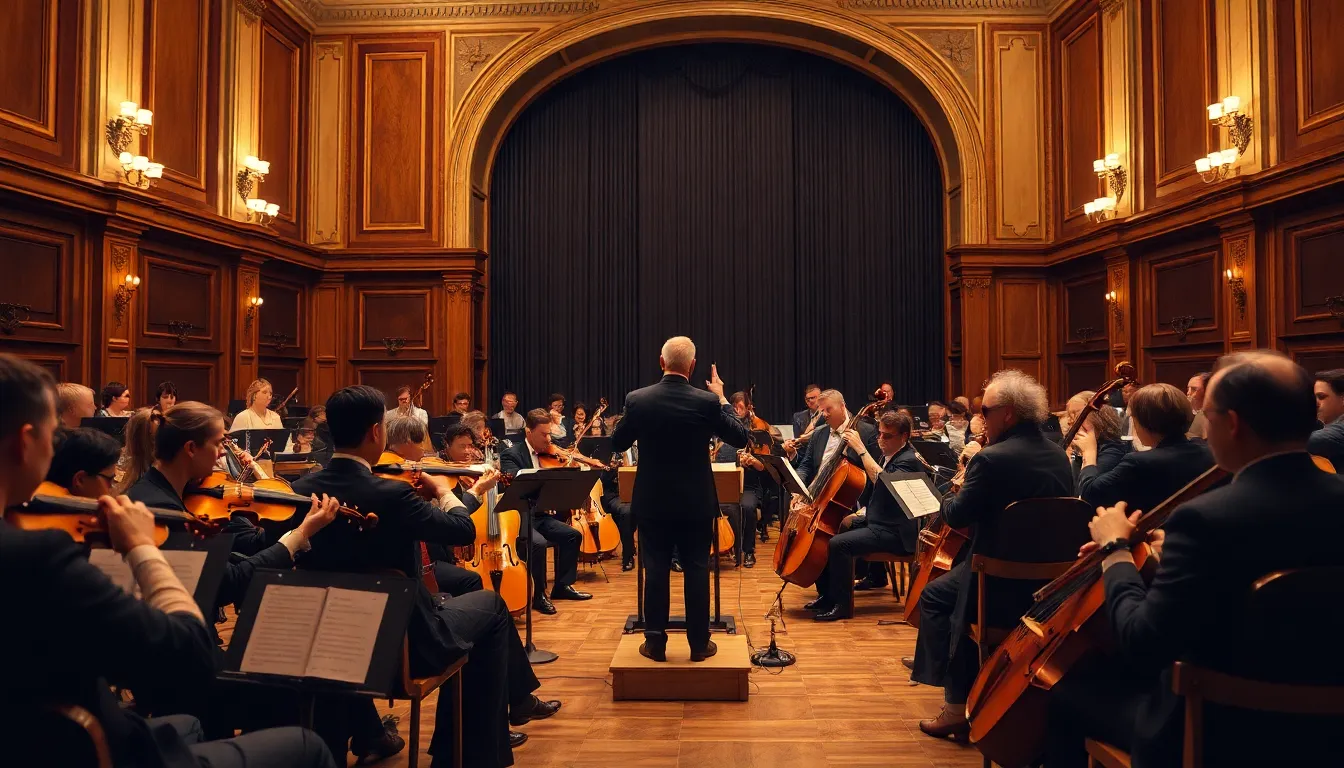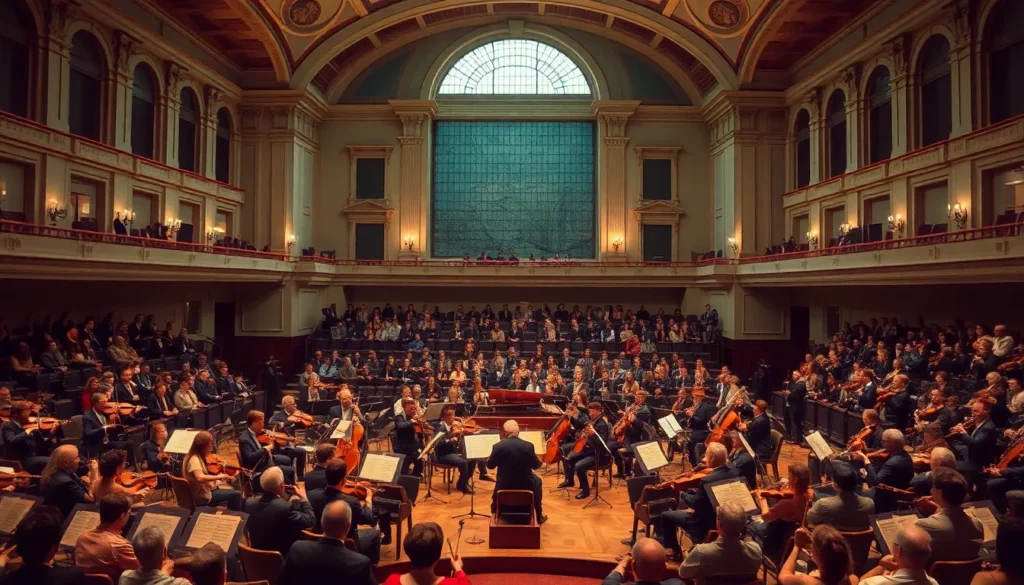Table of Contents
ToggleWhen it comes to symphonies, it’s not just about the notes; it’s about the emotions that sweep you off your feet and the stories that echo through time. Picture this: you’re sitting in a grand concert hall, the lights dim, and suddenly, the orchestra erupts into a whirlwind of sound. It’s like a rollercoaster for your ears, and it’s about to take you on a ride through the greatest symphonies ever composed.
Overview of Greatest Symphonies
Great symphonies represent the pinnacle of orchestral music, capturing the complexity of human emotions and experiences. Each composition offers a unique journey through sound, inviting listeners to engage with its themes. Beethoven’s Symphony No. 9 stands out with its choral finale, delivering a powerful message of unity.
Brahms’ Symphony No. 1 showcases a rich tapestry of harmonies, illustrating profound depth and passion. Tchaikovsky’s Symphony No. 5 takes audiences on a dramatic expedition through fate and struggle. Mahler’s Symphony No. 2, known as the “Resurrection,” beautifully balances despair and hope, celebrating life’s cyclical nature.
Mozart’s Symphony No. 41, called “Jupiter,” exemplifies classical elegance and complexity. This symphony features intricate counterpoint, highlighting Mozart’s mastery of form. Dvořák’s Symphony No. 9, “From the New World,” draws on American themes, merging folk elements with symphonic tradition.
Each symphony contains distinctive characteristics that resonate across generations. Composers often sought not only to entertain but also to provoke thought and introspection. In live performances, audiences experience these works in their full glory, where the synergy between musicians brings each piece to life.
Understanding symphonic context enhances appreciation. Various styles and eras, ranging from Romantic to Contemporary, shape the evolution of symphonies. Recognizing these influences can deepen the connection listeners feel with the music.
Historical Context

Understanding the historical context of symphonies enriches appreciation. The evolution of musical styles and cultural movements shapes composers’ works.
Classical Period
Composers like Haydn and Mozart define the Classical Period. Symphonies during this era emphasized form, structure, and clarity. Compositions typically featured a four-movement format that showcased symphonic balance. The orchestra expanded in size, allowing for richer textures. Innovation flourished, as these composers developed themes and motifs that remain influential. Mozart’s Symphony No. 41, “Jupiter,” exemplifies the elegant and refined qualities of the period, blending complexity with accessibility.
Romantic Period
The Romantic Period sees an emotional shift in symphonic music. Composers like Tchaikovsky and Brahms explore deeper feelings, storytelling, and personal expression. Music becomes a reflection of the human condition, capturing both triumph and turmoil. Symphonic structures become more flexible, allowing for experimentation. Tchaikovsky’s Symphony No. 5, for instance, highlights fate’s dramatic struggle, while Brahms’ Symphony No. 1 offers profound emotional depth. The period enhances the connection between audience and orchestra through powerful melodies and rich harmonies.
Noteworthy Composers
Many composers have left an indelible mark on the symphonic landscape. Their contributions shape our understanding and appreciation of orchestral music.
Beethoven
Ludwig van Beethoven stands among the giants of classical music. His Symphony No. 9 introduces the “Ode to Joy,” a universal celebration of brotherhood. Mastery of form and emotion defines his work, as seen in Symphony No. 5, which conveys struggle and triumph. The innovative use of motifs throughout his symphonies influences countless composers. Audiences continue to resonate with his exploration of human experience, making his symphonies timeless classics.
Mahler
Gustav Mahler’s symphonic approach embraces profound emotional depth. His Symphony No. 2, known as the “Resurrection,” addresses themes of life and afterlife, blending tragedy and hope. Mahler’s intricate orchestration and expansive structures engage listeners in a richly layered experience. Each movement unfolds a narrative, allowing emotional exploration in a unique way. His compositions bridge classical traditions and modern sensibilities, ensuring ongoing relevance and admiration.
Tchaikovsky
Pyotr Ilyich Tchaikovsky captivates audiences with his expressive melodies and vivid orchestration. Symphony No. 5 is particularly noted for its dramatic representation of fate. This work contrasts tension and resolution, keeping listeners on the edge of their seats. Tchaikovsky’s emotional intensity embodies the Romantic spirit, inviting listeners into his personal world. He masterfully combines thematic development with lush harmonies, reinforcing his place in the symphonic canon.
Analysis of Iconic Symphonies
Symphonies reveal profound narratives and emotional journeys. Each masterwork showcases the essence of its composer’s unique voice.
Symphony No. 5 by Beethoven
Beethoven’s Symphony No. 5, completed in 1808, captures the spirit of triumph through adversity. The iconic four-note motif instantly resonates with listeners, symbolizing fate knocking at the door. This symphony, structured in four movements, transitions from a tense opening to a victorious conclusion. Its dynamic orchestration and compelling themes showcase Beethoven’s mastery in blending power with nuance. As audiences experience the progression from struggle to resolution, they feel a deep emotional connection to the music.
Symphony No. 9 by Mahler
Mahler’s Symphony No. 9, composed between 1909 and 1910, embodies a poignant farewell to life. Known for its expansive structure, this symphony features intricate orchestration and emotional depth. Each movement takes listeners on a journey through themes of nostalgia, acceptance, and transcendence. Mahler’s innovative use of orchestral color enriches the overall experience, creating a tapestry of sound that captivates. The symphony’s final Adagio delivers a quiet resignation, inviting reflection on mortality while expressing a profound sense of beauty.
Impact and Legacy
Symphonies hold profound impact and enduring legacy in the world of music. Their cultural significance extends beyond individual compositions.
Cultural Significance
Symphonies reflect the values and aspirations of their time. Each piece encapsulates the emotions and struggles faced by society, contributing to a shared cultural identity. For instance, Beethoven’s Symphony No. 9 promotes themes of brotherhood and unity amid turmoil. Similarly, Mahler’s works often resonate with feelings of loss and redemption, embodying a collective yearning for connection. Composers like Dvořák introduced elements from their cultural backgrounds, enriching the symphonic form. The evolution of symphonies showcases how music mirrors historical moments, inspiring social movements and artistic expressions across centuries.
Influence on Modern Music
Modern composers draw inspiration from the grandeur of symphonies. Contemporary works often integrate symphonic structures, expanding musical boundaries. Elements from classical symphonies appear in various genres, including film scores, rock, and pop music. For example, composers like John Williams utilize orchestral techniques in cinematic storytelling, enhancing emotional depth. Similarly, artists such as Coldplay incorporate symphonic arrangements in their songs, bridging classical and modern influences. Today’s music, shaped by historical symphonic traditions, continues to captivate audiences worldwide.
The journey through the greatest symphonies reveals a rich tapestry of emotions and narratives that resonate deeply with listeners. Each composition serves as a timeless reflection of human experience, inviting audiences to connect with the music on a profound level.
As symphonies continue to evolve, they inspire new generations of composers and musicians. Their impact on culture and society remains significant, demonstrating that the power of orchestral music transcends time. Embracing the legacy of these masterpieces allows for a deeper appreciation of the artistry involved in symphonic creation.





